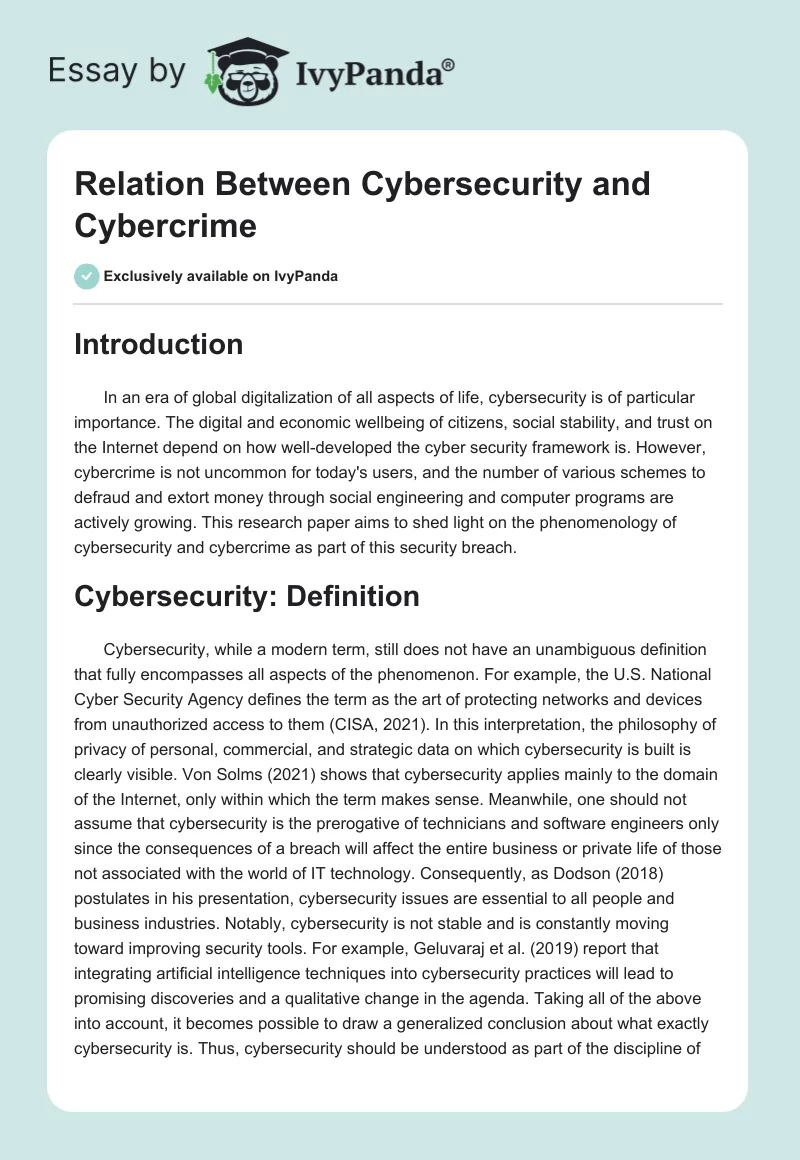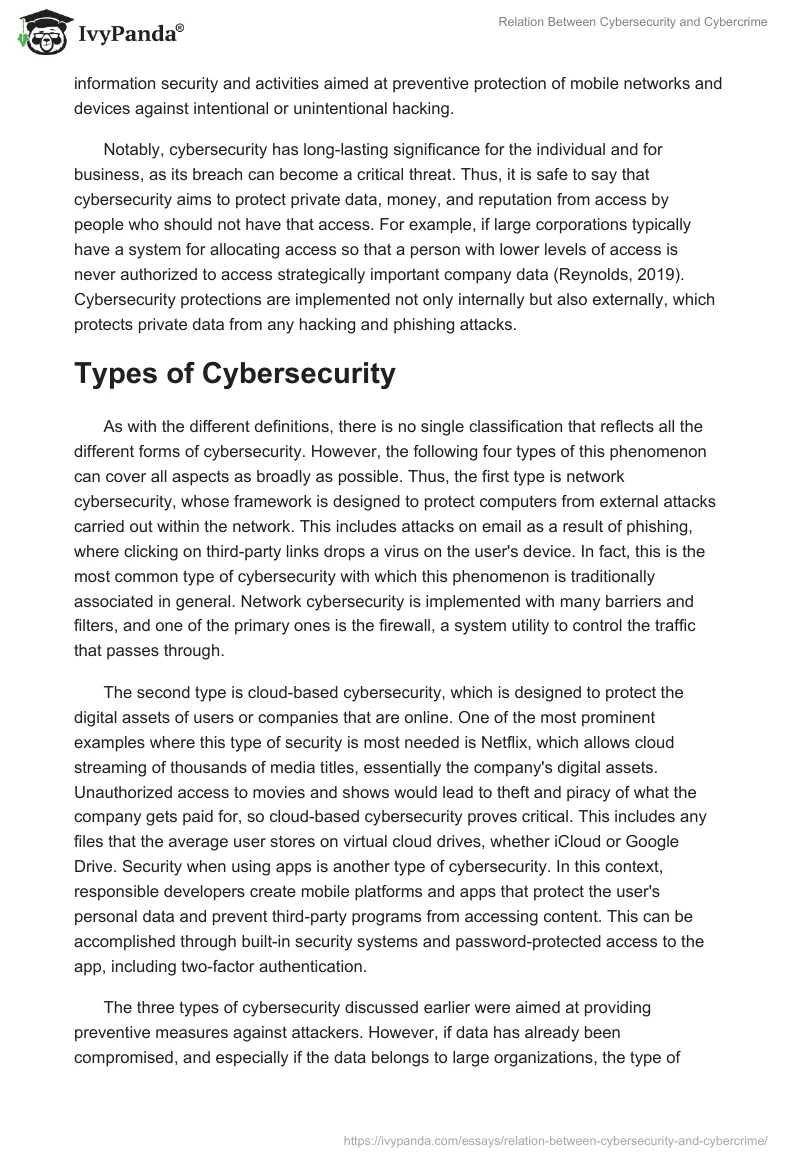Introduction
In an era of global digitalization of all aspects of life, cybersecurity is of particular importance. The digital and economic wellbeing of citizens, social stability, and trust on the Internet depend on how well-developed the cyber security framework is. However, cybercrime is not uncommon for today’s users, and the number of various schemes to defraud and extort money through social engineering and computer programs are actively growing. This research paper aims to shed light on the phenomenology of cybersecurity and cybercrime as part of this security breach.
Cybersecurity: Definition
Cybersecurity, while a modern term, still does not have an unambiguous definition that fully encompasses all aspects of the phenomenon. For example, the U.S. National Cyber Security Agency defines the term as the art of protecting networks and devices from unauthorized access to them (CISA, 2021). In this interpretation, the philosophy of privacy of personal, commercial, and strategic data on which cybersecurity is built is clearly visible. Von Solms (2021) shows that cybersecurity applies mainly to the domain of the Internet, only within which the term makes sense. Meanwhile, one should not assume that cybersecurity is the prerogative of technicians and software engineers only since the consequences of a breach will affect the entire business or private life of those not associated with the world of IT technology. Consequently, as Dodson (2018) postulates in his presentation, cybersecurity issues are essential to all people and business industries. Notably, cybersecurity is not stable and is constantly moving toward improving security tools. For example, Geluvaraj et al. (2019) report that integrating artificial intelligence techniques into cybersecurity practices will lead to promising discoveries and a qualitative change in the agenda. Taking all of the above into account, it becomes possible to draw a generalized conclusion about what exactly cybersecurity is. Thus, cybersecurity should be understood as part of the discipline of information security and activities aimed at preventive protection of mobile networks and devices against intentional or unintentional hacking.
Notably, cybersecurity has long-lasting significance for the individual and for business, as its breach can become a critical threat. Thus, it is safe to say that cybersecurity aims to protect private data, money, and reputation from access by people who should not have that access. For example, if large corporations typically have a system for allocating access so that a person with lower levels of access is never authorized to access strategically important company data (Reynolds, 2019). Cybersecurity protections are implemented not only internally but also externally, which protects private data from any hacking and phishing attacks.
Types of Cybersecurity
As with the different definitions, there is no single classification that reflects all the different forms of cybersecurity. However, the following four types of this phenomenon can cover all aspects as broadly as possible. Thus, the first type is network cybersecurity, whose framework is designed to protect computers from external attacks carried out within the network. This includes attacks on email as a result of phishing, where clicking on third-party links drops a virus on the user’s device. In fact, this is the most common type of cybersecurity with which this phenomenon is traditionally associated in general. Network cybersecurity is implemented with many barriers and filters, and one of the primary ones is the firewall, a system utility to control the traffic that passes through.
The second type is cloud-based cybersecurity, which is designed to protect the digital assets of users or companies that are online. One of the most prominent examples where this type of security is most needed is Netflix, which allows cloud streaming of thousands of media titles, essentially the company’s digital assets. Unauthorized access to movies and shows would lead to theft and piracy of what the company gets paid for, so cloud-based cybersecurity proves critical. This includes any files that the average user stores on virtual cloud drives, whether iCloud or Google Drive. Security when using apps is another type of cybersecurity. In this context, responsible developers create mobile platforms and apps that protect the user’s personal data and prevent third-party programs from accessing content. This can be accomplished through built-in security systems and password-protected access to the app, including two-factor authentication.
The three types of cybersecurity discussed earlier were aimed at providing preventive measures against attackers. However, if data has already been compromised, and especially if the data belongs to large organizations, the type of operational cybersecurity is implemented, acting urgently and ex post facto. Operational cybersecurity is needed to minimize the damage from a hacker attack and, if possible, regain access to the data. This includes working to ensure backup plans and creating reinforced encryption of employee data.
Cybercrime: Definition
No matter how much the cybersecurity framework is developed, however, it will never be enough to guarantee one hundred percent protection from hacking. Cybercrime will always exist and evolve because, as Bhatia (2019) said, “without a cyber-attack, the concept of cybersecurity cannot exist” (p. 55). Cybercrime is interpreted in different ways, and among its definitions, one can find that cybercrime is any form of crime that is committed through the use of a computer (Panda Security, 2021). An interesting perspective on cybercrime is found in Collier et al. (2021), who pointed out that the decision to engage in virtual crime often involves a sense of boredom. An important property is highlighted by Sarre et al. (2018), who pointed out that cybercrime remains a serious societal problem requiring urgent action by law enforcement orders. The synthesis of everything described leads to the conclusion that cybercrime is, in general, any crime that is committed in an information technology environment.
In fact, everyone has once faced the manifestations of cybercrime, losing money, some of their data, or information that they do not want to share. Hacks in social networks happen quite often, and quite a few modern users have already been trained in the basics of online behavior so as not to become a victim of fraud. Meanwhile, the number of virtual crimes is proliferating, as is the number of ways in which cybercriminals defraud users. For example, data reports that 93.6% of malware could easily adapt so that built-in security systems do not detect their code (Zaharia, 2021). In addition, it is predicted that by 2023, more than 33 billion accounts, four times the world’s population, will be compromised (Vojinovic, 2019). Consequently, multiple cybersecurity threats continue to be relevant and are unlikely ever completely to disappear; instead, they will continue to improve and adapt continually.
Types of Cybercrimes
Cybercrimes can be roughly divided into two groups: those aimed at devices and those aimed at seizing private data. The first type of threat includes any attack by hackers whose aim is to render a computer device inoperable in order to extort it. The price to pay for unlocking a device can be money or personal data; only after transferring them can the scammers unlock the user’s computer if they want to. This category of cybercrime includes viruses, malware, and DoS attacks (Panda Security, 2021). Interestingly, comparatively recently, this category has been able to add another threat, namely hidden cryptocurrency mining on the user’s computer (Nadeau, 2021). This type of crime may seem harmless to individuals because it does not steal data, but instead, the planted beacon steals the user’s traffic and the computing power of the device in order to covertly mine cryptocurrency. The user notices a dramatic decrease in the functionality of their computer and a constant cooling system, even when the computer is not performing resource-intensive tasks.
The second category of cybercrime includes any programs and actions designed to compromise. Specifically, this includes social engineering, phishing emails, identity theft, and cyberbullying. Such threats are not only aimed at siphoning money from a user or company but may also be aimed at committing physical crimes based on the material received. Cyberbullying is a susceptible sector in this category, as it aims at depressing the mental wellbeing of individuals, which can lead to tragic consequences in real life.
Conclusion
To summarize, cybersecurity is one of the most important feature of today’s Internet-dependent civilization, investing in the protection of virtual personal data. The digitalization of almost all areas of life catalyzes the need to protect this data. However, cybersecurity is not absolute, as there is always the threat of cybercrime. Such virtual crimes have consequences beyond the Web, so cybersecurity is constantly developing new defense techniques.
References
Bhatia, D. (2019). Do you think cybersecurity is a new concept? Think again…. Cybernomics, 1(7), 55-56.
CISA. (2019). Security tip (ST04-001). Department of Homeland Security. Web.
Collier, B., Clayton, R., Hutchings, A., & Thomas, D. (2021). Cybercrime is (often) boring: infrastructure and alienation in a deviant subculture. The British Journal of Criminology, 61(5), 1-9.
Dodson, D. (2018). Cybersecurity: Is it about business or technology? Usenix. Web.
Geluvaraj, B., Satwik, P. M., & Kumar, T. A. (2019). The future of cybersecurity: Major role of artificial intelligence, machine learning, and deep learning in cyberspace. International Conference on Computer Networks and Communication Technologies, 739-747.
Nadeau, M. (2021). Cryptojacking explained: How to prevent, detect, and recover from it. CSO. Web.
Panda Security. (2021). Types of cybercrime. Panda. Web.
Reynolds, M. (2019). How to define access levels in access control systems. DGA. Web.
Sarre, R., Lau, L. Y. C., & Chang, L. Y. (2018). Responding to cybercrime: Current trends. Police Practice and Research, 19(6), 515-518.
Vojinovic, I. (2019). More than 70 cybercrime statistics – Soon to be a $6 trillion problem. Dataprot. Web.
von Solms, B. (2018). Cybersecurity and information security – what goes where? Information & Computer Security, 1-10.
Zaharia, A. (2021). 300+ terrifying cybercrime and cybersecurity statistics (2022 edition). CompariTech. Web.


